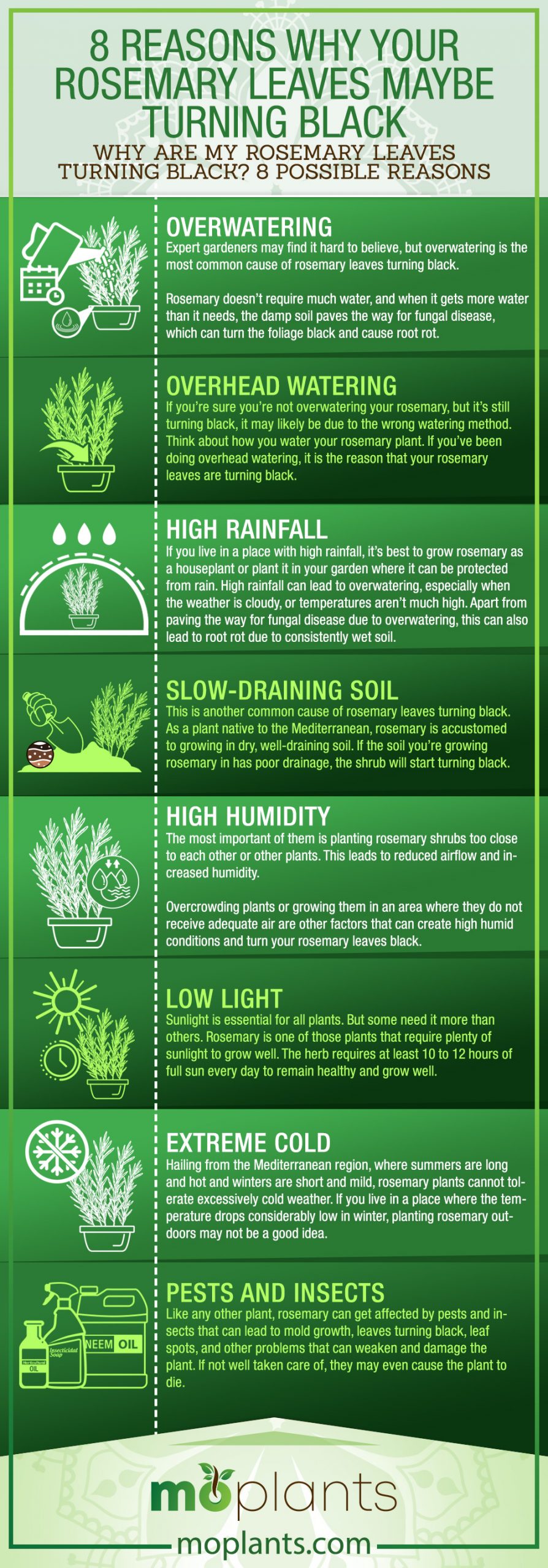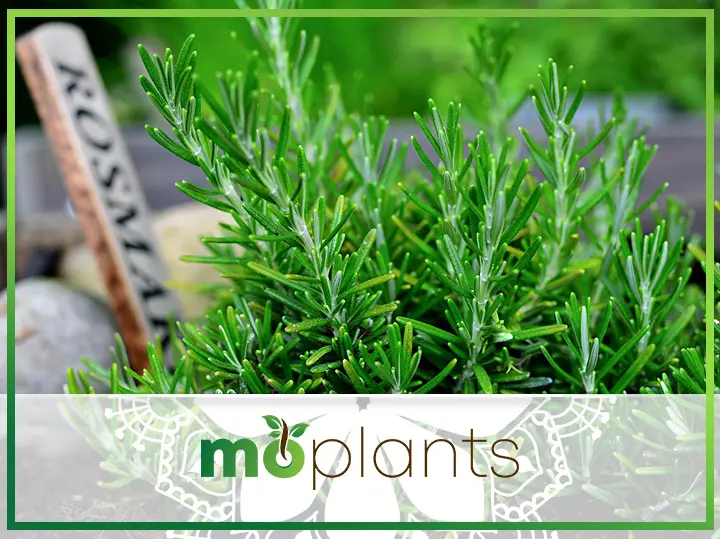Rosemary reminds us of delicious steaks, hearty, fragrant soups, stews, and roasted vegetables. The aromatic herb adds more flavor to your foods than any other herb or spice. The super-fragrant needle-like leaves of the rosemary plant feature notes of mint, sage, lavender, and citrus. It’s also easy to grow, which is why many people have rosemary plants in their kitchen gardens.
While caring for a rosemary plant is easy, it requires a few things to thrive. If these requirements aren’t met, the plant can develop certain problems. Rosemary leaves turning black is one of them. In fact, it is one of the most common problems in rosemary plants that people growing the herb in their homes complain of.
So let’s talk about it and understand what causes rosemary leaves to turn black and how it can be prevented or fixed to help you raise a healthy, happy plant.
Why Are My Rosemary Leaves Turning Black? 8 Possible Reasons
There can be multiple factors responsible for rosemary leaves turning black. These include:
Overwatering
Rosemary is a Mediterranean herb, which means the plant is native to the arid region. Most people overlook this when growing rosemary at home and end up watering the plant more than it needs.
Expert gardeners may find it hard to believe, but overwatering is the most common cause of rosemary leaves turning black.
Rosemary doesn’t require much water, and when it gets more water than it needs, the damp soil paves the way for fungal disease, which can turn the foliage black and cause root rot.
Here are a few things to remember with regards to watering a rosemary plant to avoid black foliage:
- Water the plant only once every two weeks in hot weather. For plants growing in the garden, hold back on it, too, if there has been significant rainfall.
- Do not water your rosemary plant in cold weather. Watering in winter can make rosemary plants more vulnerable to the pathogens that cause the fungal disease and turn the foliage and stems black.
The key to preventing overwatering a rosemary plant is to let the roots dry out between watering.
Overwatering can be detrimental to rosemary and cause your plant to die. Avoid it at all costs to keep your herb plant healthy.
Overhead Watering
If you’re sure you’re not overwatering your rosemary, but it’s still turning black, it may likely be due to the wrong watering method. Think about how you water your rosemary plant. If you’ve been doing overhead watering, it is the reason that your rosemary leaves are turning black.
Overhead watering leads to persistently damp foliage, which creates a favorable environment for mildew growth and dark spots on rosemary leaves, making them turn black. It’s more likely to happen in cooler temperatures when the evaporation rate is low and water remains on the leaves for more prolonged periods after every watering episode. In full sun and hot weather, the risk reduces a bit as the evaporation rate is high.
But, to avoid damage, it’s best to always water the rosemary plant at the base, regardless of the weather.
Overhead watering a rosemary plant (or any plant, per se) that has developed mildew can cause the fungus to spread to the whole plant.
One key distinguishing feature of rosemary being damaged by overhead watering is that it causes the tips of the leaves to turn black. This can be useful to determine the cause of rosemary leaves turning black for those who may have someone else water their plants and not do it on their own. Inspecting the leaves closely can help you determine if it’s due to the wrong watering method.
High Rainfall
If you live in a place with high rainfall, it’s best to grow rosemary as a houseplant or plant it in your garden where it can be protected from rain. High rainfall can lead to overwatering, especially when the weather is cloudy, or temperatures aren’t much high. Apart from paving the way for fungal disease due to overwatering, this can also lead to root rot due to consistently wet soil.
If you don’t have the option to protect your rosemary from rain, you may try avoiding the damage by reducing the watering frequency. If there’s a lot of rainfall and not enough sunlight, you may completely stop watering the plant. But if the sun is out, too, along with rain, water less frequently; once every three weeks or so.
Remember that it will likely take a bit of trial and error to figure out the right watering frequency in such situations.
Slow-Draining Soil
This is another common cause of rosemary leaves turning black. As a plant native to the Mediterranean, rosemary is accustomed to growing in dry, well-draining soil. If the soil you’re growing rosemary in has poor drainage, the shrub will start turning black.
Grow your rosemary plant in sandy, stony soil. Avoid using rich compost and clay soil. They are slow-draining and will damage your plant by retaining much more water than it requires. The excessive moisture in the soil creates unfavorable conditions for rosemary and causes several problems. Leaves turning black is just one of them. Slow-draining soil also impacts the plant’s growth rate and can lead to fungal infection and root rot.
One way to improve soil drainage is to amend it with grit or horticultural sand. The soil mixture should have at least 20% grit or sand. But if your region receives a lot of rainfall, you will be better with an even higher percentage of it to ensure quick drainage.
High Humidity
Considering that the weather in the Mediterranean region is hot and dry, it shouldn’t be a surprise that rosemary plants cannot tolerate high humidity levels. But what’s important to note here is that people often only consider the overall humidity levels in the air and overlook the fact that some other factors can create a micro-climate with high relative humidity, putting their rosemary plants at risk of damage and turning black. The most important of them is planting rosemary shrubs too close to each other or other plants. This leads to reduced airflow and increased humidity.
Overcrowding plants or growing them in an area where they do not receive adequate air are other factors that can create high humid conditions and turn your rosemary leaves black.
In case you’re wondering how high humidity causes the leaves to turn black, it results from fungal infection and leaf spots that are the direct impact of high humidity levels.
Humidity can also put rosemary plants at risk of developing root rot, which can also turn the leaves black.
To avoid creating humid micro-climates, grow the plants in an open area with enough air flow and make sure your rosemary shrubs are at least 3 feet apart, not only from each other but also from other plants. For those living in humid regions, growing rosemary in pots and containers with adequate drainage is the best option.
Low Light
Sunlight is essential for all plants. But some need it more than others. Rosemary is one of those plants that require plenty of sunlight to grow well. The herb requires at least 10 to 12 hours of full sun every day to remain healthy and grow well.
While low light conditions may not have an immediate impact on rosemary plants, they can cause several problems, including stunted growth and blackened leaves, over time. The unavailability of an adequate amount of sunlight for a long time will eventually lead to the shedding of leaves, causing the plant to dry out and die.
Whether you’re growing rosemary in the garden or indoors, make sure to choose a spot where it receives bright light for the most part of the day.
Extreme Cold
Hailing from the Mediterranean region, where summers are long and hot and winters are short and mild, rosemary plants cannot tolerate excessively cold weather. If you live in a place where the temperature drops considerably low in winter, planting rosemary outdoors may not be a good idea. Extreme cold can turn the leaves black and may even cause your plant to die. Grow the herb in a container and bring it inside in the winter to protect it from the cold. But make sure it continues to get adequate sunlight inside.
Pests and Insects
Like any other plant, rosemary can get affected by pests and insects that can lead to mold growth, leaves turning black, leaf spots, and other problems that can weaken and damage the plant. If not well taken care of, they may even cause the plant to die.
Some of the common pests and insects that can attack rosemary include mealybugs, thrips, whiteflies, mites, aphids, and spiders. There can be many others, too, but these are the most common culprits of insect damage and pest infestation in rosemary shrubs.
To avoid the problems caused by pests and insects, it’s important to keep an eye on your rosemary plant. Inspect it closely every time you water it and look for the signs of these tiny bugs. When you spot any, resort to treatment immediately.
Considering that people generally grow rosemary for consumption, you should avoid using toxic pesticides and stick to using natural remedies.
Neem oil, horticultural oils, and insecticidal soaps make great non-toxic options.
Infographic

How to Treat a Rosemary Plant That Has Leaves Turning Black?
The solution to rosemary leaves turning black can vary depending on the root cause of the problem. For your convenience, here’s a list of quick solutions to the issues identified above:
- If the problem is due to overwatering, simply scale back and water your rosemary plant every two to four weeks depending on how hot the weather is. Avoid watering rosemary during the winter weather or water only rarely.
- If you have been doing overhead watering, stop it and water at the base of the plant. If the plant isn’t already too damaged, the problem will fix on its own.
- Use high-draining soils. As mentioned above, you can add 20% sand or grit to your multipurpose compost to improve drainage. Also, if you’re growing rosemary in a pot, make sure it has adequate drainage.
- Grow your rosemary shrubs in well-ventilated areas with good airflow, and maintain a distance of at least three feet to avoid creating high humidity conditions.
- Avoid low-light conditions and make sure your plant gets full sun and an average of 10 to 12 hours of sunlight on a daily basis.
- Use natural remedies to control pests and insects.
- Treat the plant with high-quality, eco-friendly fungicides to treat black spots, root rot, and other fungal infections. Don’t forget to snip the affected leaves before doing it. For root rot, you also have to remove the infected roots.
Growing Healthy Rosemary Plants Is Easier Than It May Seem
Maintaining healthy plants, protecting them from problems, and ensuring they grow well may sometimes feel overwhelming, especially for those new to gardening. However, it’s often easier than it may seem. The key is to know the native region of the plant and mimic its conditions. For rosemary, replicate the growing conditions of the Mediterranean region, and your herb will grow just fine. To reiterate, the Mediterranean region is hot and dry with low humidity and well-draining soils. Provide the rosemary in your home with all these elements to avoid black leaves and many other problems.

